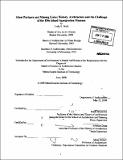Silent partners and missing links : history, architecture and the challenge of the Ellis Island Immigration Museum
Author(s)
Weld, Linda R. (Linda Ruth)
DownloadFull printable version (40.00Mb)
Alternative title
History, architecture and the challenge of the Ellis Island Immigration Museum
Other Contributors
Massachusetts Institute of Technology. Dept. of Architecture.
Advisor
Mark Jarzombek and Arindam Dutta.
Terms of use
Metadata
Show full item recordAbstract
As this nation's first and largest immigration station Ellis Island not only processed millions of immigrants, but also functioned to develop mechanisms of control and procedures for inspecting thousands of immigrants on a daily basis. Ellis Island operated at the intersection of conflicting cultural paradigms as economic concerns exacerbated by the influx of unskilled laborers before the turn of the century shifted to fears that the large numbers of "new" immigrants from southern and eastern Europe would degrade the gene pool of "old" American stock. The persistent perception of immigrants as vectors of disease that lay behind these fears did not disappear after the turn of the century. Rather, that perception evolved to embrace the belief that science would clearly demonstrate that some people, because of their racial or national constitution, were less capable of becoming 100% Americanized than others. The Ellis Island Immigration Museum, housed in the restored main building on Ellis Island, presently ignores the presence and narrative potential of the traces of immigrant processing and the many remarkable structures which would bring Ellis Island's unique role in the history of immigration to light. My purpose in this thesis is to foreground the role of the United States government at Ellis Island, and offer a critique of the manner in which the success of the Ellis Island Immigration Museum frustrates a full consideration of the complex historical processes it is meant to commemorate.
Description
Thesis (S.M.)--Massachusetts Institute of Technology, Dept. of Architecture, 2008. Includes bibliographical references (leaves 87-93).
Date issued
2008Department
Massachusetts Institute of Technology. Department of ArchitecturePublisher
Massachusetts Institute of Technology
Keywords
Architecture.